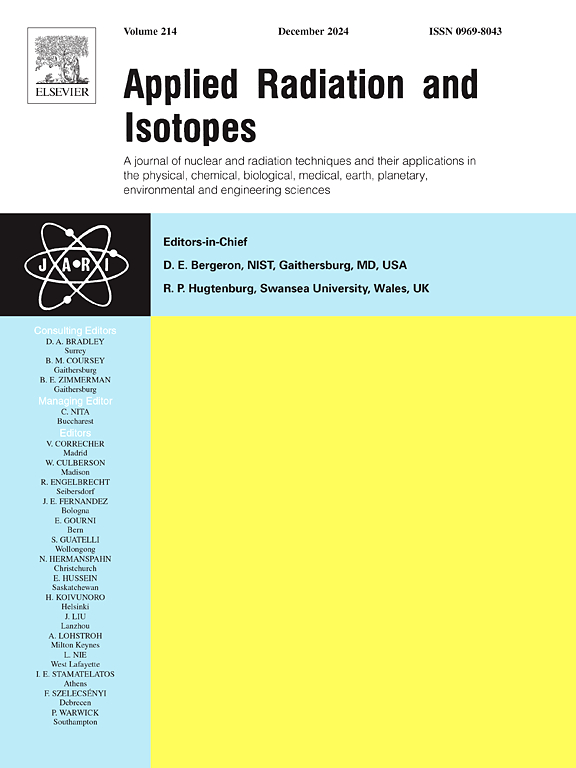Studies of structural and trapping parameters of gamma irradiated biochar for dosimetric applications
IF 1.8
3区 工程技术
Q3 CHEMISTRY, INORGANIC & NUCLEAR
引用次数: 0
Abstract
Biochar, a low-cost and environment-friendly material, possesses favorable physical and chemical properties towards dosimetric applications. The current investigation concentrated on the structural and thermoluminescence (TL) trapping parameters of biochar influenced by gamma-ray doses ranging from 0 to 200 Gy. The TL glow curves of gamma irradiated biochar samples have been analyzed by several well-established models viz initial rise, peak shape and curve fitting methods for estimating the fundamental trap parameters, i.e., kinetic order (b), activation energy (E) and frequency factor (s). The calculated geometric factor (μg) ranges between 0.50 and 0.56, indicating that the kinetic parameters can be appropriately determined using Chen's general-order kinetic model. The measured activation energy range (0.30–0.38 eV), along with the corresponding frequency factor, suggests that the biochar contains moderately stable trapping centers. These features collectively support the material's potential for reliable passive TL dosimetry, combining effective charge retention with efficient carrier release upon thermal stimulation. Tmax-Tstop experiment was also performed and six subpeaks under the glow curve were located. The structural and morphological changes brought on by the radiation doses are being observed using SEM-EDX, Raman spectra and X-ray diffraction (XRD). SEM-EDX study validates the dose-dependent microstructural damage of biochar. The dose-dependent structural alterations and self-annealing with increasing gamma doses were clearly indicated by the intensity ratio (ID/IG), obtained from raman spectra. The crystallite size obtained from the generalized Tuinstra-Koenig equation is inversely proportional to the intensity ratio (ID/IG), confirms the defect generation with the increasing radiation doses. Through the examination of crystallite size (D), dislocation density (δ), lattice strain (ɛ), and FWHM from XRD patterns, additional validation of dose-dependent variation of TL trapping parameters was obtained. Analysis of the structural and trapping attributes reveals the structural alterations induced by gamma irradiation. Consequently, it is evidently noticeable that biochar possesses considerable potential for dosimetric applications.
射线辐照生物炭的结构和捕获参数的剂量学研究
生物炭是一种低成本、环境友好的材料,具有良好的物理和化学性质,可用于剂量测定。目前的研究主要集中在0 ~ 200 Gy γ射线剂量对生物炭结构和热释光捕获参数的影响。利用几种已建立的模型,即初始上升、峰形和曲线拟合方法,分析了伽马辐照生物炭样品的TL发光曲线,以估计基本的陷阱参数,即动力学阶数(b)、活化能(E)和频率因子(s)。计算的几何因子(μg)在0.50 ~ 0.56之间,表明采用Chen的一般阶动力学模型可以较好地确定动力学参数。测定的活化能范围(0.30 ~ 0.38 eV)及相应的频率因子表明,生物炭具有中等稳定的捕获中心。这些特性共同支持材料的潜力,可靠的被动TL剂量测定,结合有效的电荷保留和有效的载流子释放热刺激。并进行了Tmax-Tstop实验,确定了发光曲线下的6个子峰。利用SEM-EDX、拉曼光谱和x射线衍射(XRD)观察了辐照剂量引起的结构和形态变化。SEM-EDX研究证实了生物炭的剂量依赖性微观结构损伤。喇曼光谱的强度比(ID/IG)清楚地显示了随γ剂量增加的剂量依赖性结构改变和自退火。由广义Tuinstra-Koenig方程得到的晶体尺寸与强度比(ID/IG)成反比,证实了缺陷随辐射剂量的增加而产生。通过XRD分析晶体尺寸(D)、位错密度(δ)、晶格应变(ε)和FWHM,进一步验证了TL捕获参数的剂量依赖性变化。对结构和俘获特性的分析揭示了伽玛辐照引起的结构变化。因此,生物炭具有相当大的剂量学应用潜力是显而易见的。
本文章由计算机程序翻译,如有差异,请以英文原文为准。
求助全文
约1分钟内获得全文
求助全文
来源期刊

Applied Radiation and Isotopes
工程技术-核科学技术
CiteScore
3.00
自引率
12.50%
发文量
406
审稿时长
13.5 months
期刊介绍:
Applied Radiation and Isotopes provides a high quality medium for the publication of substantial, original and scientific and technological papers on the development and peaceful application of nuclear, radiation and radionuclide techniques in chemistry, physics, biochemistry, biology, medicine, security, engineering and in the earth, planetary and environmental sciences, all including dosimetry. Nuclear techniques are defined in the broadest sense and both experimental and theoretical papers are welcome. They include the development and use of α- and β-particles, X-rays and γ-rays, neutrons and other nuclear particles and radiations from all sources, including radionuclides, synchrotron sources, cyclotrons and reactors and from the natural environment.
The journal aims to publish papers with significance to an international audience, containing substantial novelty and scientific impact. The Editors reserve the rights to reject, with or without external review, papers that do not meet these criteria.
Papers dealing with radiation processing, i.e., where radiation is used to bring about a biological, chemical or physical change in a material, should be directed to our sister journal Radiation Physics and Chemistry.
 求助内容:
求助内容: 应助结果提醒方式:
应助结果提醒方式:


